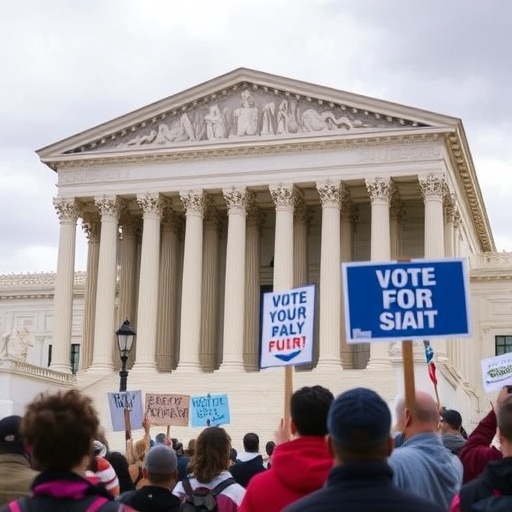Supreme Court Signals Deeper Cuts to Voting Rights Act: Alarming Implications for U.S. Elections
In a development that has sent shockwaves through the civil rights community, the U.S. Supreme Court has hinted at potentially dismantling key protections of the Voting Rights Act during recent oral arguments, raising fears of a significant erosion in electoral law safeguards. Justices’ pointed questions and skeptical tones suggest the judiciary may be poised to further limit the 1965 landmark legislation, which has long served as a bulwark against voter discrimination. This comes at a time when voting access remains a flashpoint in American democracy, with advocates warning that such a move could disenfranchise millions, particularly in minority communities.
- Justices’ Oral Arguments Expose Deep Divisions on Voting Protections
- Tracing the Voting Rights Act’s Legacy Amid Mounting Challenges
- Civil Rights Advocates Rally Against Perceived Judicial Overreach
- Electoral Law Experts Predict Ripple Effects on National Politics
- Path Forward: Battling for Voting Rights in a Divided Judiciary
The case at hand, Merrill v. Milligan, challenges the constitutionality of certain redistricting practices under Section 2 of the Voting Rights Act. During arguments on October 4, 2023, several conservative justices expressed doubts about the Act’s ongoing applicability, echoing the 2013 Shelby County v. Holder decision that gutted the law’s preclearance formula. “The Voting Rights Act was meant to address historical injustices, but has it outlived its purpose?” Justice Samuel Alito queried, a remark that civil rights groups interpret as a prelude to further weakening.
This isn’t just legal jargon; it’s a direct threat to the civil rights progress forged over decades. With midterm elections approaching and ongoing battles over voter ID laws and polling place closures, the Supreme Court‘s signals could reshape electoral law for generations. According to the Brennan Center for Justice, states have introduced over 250 restrictive voting bills since 2020, many of which could go unchecked without robust Voting Rights Act enforcement.
Justices’ Oral Arguments Expose Deep Divisions on Voting Protections
The Supreme Court’s oral arguments in Merrill v. Milligan laid bare the ideological fault lines within the judiciary, with conservative justices appearing ready to curtail the Voting Rights Act’s reach. Chief Justice John Roberts, who authored the Shelby County opinion, pressed attorneys on whether race-based considerations in redistricting violate equal protection principles under the 14th Amendment. “We’re in a new era,” Roberts stated, implying that the Act’s race-conscious remedies might now be outdated in a “post-racial” society—a notion hotly contested by liberals.
Justice Clarence Thomas, known for his originalist views, went further, questioning the very foundation of Section 2, which prohibits voting practices that dilute minority votes. Thomas’s silence during much of the argument was telling; his past dissents have consistently advocated for narrowing civil rights statutes. Meanwhile, Justice Sonia Sotomayor, the Court’s lone liberal voice in some exchanges, passionately defended the Act: “Without these protections, states will revert to the discriminatory practices that necessitated the Voting Rights Act in the first place.” Her words underscored the emotional stakes, evoking memories of Bloody Sunday and the Selma marches that birthed the legislation.
Legal experts monitoring the session noted that Justice Brett Kavanaugh’s line of questioning could be pivotal. He probed the balance between preventing gerrymandering and avoiding racial quotas, suggesting a middle ground that might still erode protections. “The Court is signaling that the Voting Rights Act must evolve or face obsolescence,” said election law professor Rick Hasen of UC Irvine. This division isn’t abstract; it directly impacts how congressional districts are drawn, potentially affecting representation for Black, Latino, and Native American voters who make up 40% of the U.S. population, per Census data.
Statistics from the U.S. Commission on Civil Rights highlight the urgency: In the 2022 midterms, voters of color waited an average of 28% longer at polls in states without strong Voting Rights Act oversight. If the Court leans toward restriction, these disparities could widen, fueling accusations of a judiciary out of touch with electoral realities.
Tracing the Voting Rights Act’s Legacy Amid Mounting Challenges
The Voting Rights Act of 1965 stands as a cornerstone of American civil rights, born from the ashes of Jim Crow-era suppression. Signed by President Lyndon B. Johnson just months after the Voting Rights Act’s passage was spurred by the brutal beating of marchers on Selma’s Edmund Pettus Bridge, the law banned literacy tests, poll taxes, and other barriers that had disenfranchised Black Americans for nearly a century. Section 5’s preclearance requirement forced states with histories of discrimination—mostly in the South—to get federal approval for voting changes, a provision that blocked over 1,000 discriminatory measures by 2013.
But the Supreme Court’s 2013 Shelby County v. Holder ruling changed everything. By invalidating the coverage formula for preclearance, the decision unleashed a torrent of restrictive laws. Alabama, for instance, swiftly closed 31 polling places in Black Belt counties, reducing access by 20% in some areas. The judiciary’s conservative majority argued the formula was outdated, citing increased Black voter registration from 7% in 1965 to 62% today. Yet critics, including the NAACP, counter that discrimination persists: A 2021 study by the ACLU found that 19 states enacted laws making it harder to vote, disproportionately affecting communities of color.
Enter Merrill v. Milligan, which tests whether Alabama’s congressional map—drawn after the 2020 Census—unlawfully dilutes Black voting power. The state, covered under Shelby‘s fallout, created only one majority-Black district out of seven, despite Black residents comprising 27% of the population. Lower courts ruled this violated Section 2, but the Supreme Court paused enforcement, allowing the map for 2022 elections. This intervention alone signals the judiciary’s willingness to prioritize state autonomy over federal civil rights oversight.
Historical parallels abound. The Act’s passage followed the 15th Amendment’s unfulfilled promise, ratified in 1870 but ignored through violence and intimidation. Today, with digital gerrymandering tools enabling precise voter suppression, the stakes are higher. As Vanita Gupta, former head of the DOJ’s Civil Rights Division, noted in a recent op-ed, “The Voting Rights Act isn’t a relic; it’s a living shield against evolving threats to electoral law.”
Civil Rights Advocates Rally Against Perceived Judicial Overreach
Voting rights advocates are sounding the alarm, framing the Supreme Court’s signals as an existential threat to civil rights. The Leadership Conference on Civil and Human Rights, a coalition of over 200 groups, issued a statement post-arguments: “This judiciary is poised to undo decades of progress, leaving electoral law vulnerable to partisan manipulation.” Their concerns are rooted in real-world impacts; in Georgia, post-Shelby, a 2018 law criminalized handing out water to voters in long lines, a tactic that hit Black voters hardest.
Prominent voices like Stacey Abrams, founder of Fair Fight Action, have been vocal. “The Supreme Court is not just interpreting law; it’s rewriting history,” Abrams said in an MSNBC interview. She pointed to statistics showing that restrictive voting laws suppressed turnout by 2-3% among minorities in 2020, per MIT election data. The Southern Poverty Law Center echoed this, reporting a surge in voter intimidation cases—up 25% since 2016—in states like Texas and Florida, where lax electoral law enforcement prevails.
On the ground, grassroots efforts are intensifying. In Alabama, where the Milligan case originated, activists like Marcia Folsom of Black Voters Matter are mobilizing. “We’ve fought for every vote since Reconstruction; we won’t stop now,” Folsom told reporters. Organizations are pushing for legislative fixes, like the John Lewis Voting Rights Advancement Act, stalled in Congress since 2021. This bill would restore preclearance and update the formula based on recent discrimination data, but with a divided Senate, its fate hangs in the balance.
International observers, including the OSCE, have criticized U.S. voting practices as regressive, noting in a 2022 report that weakened Voting Rights Act provisions contribute to perceptions of democratic backsliding. Domestically, polls from Pew Research show 68% of Americans support stronger voting protections, transcending party lines—a rare consensus amid polarized debates.
Electoral Law Experts Predict Ripple Effects on National Politics
If the Supreme Court further erodes the Voting Rights Act, the fallout for electoral law could be profound, experts warn. Redistricting battles, already contentious, might favor partisan maps without Section 2’s guardrails. In 2022, the Princeton Gerrymandering Project identified 187 congressional districts as potentially unfair, many in states like North Carolina and Ohio where minority votes were diluted. A ruling against robust enforcement could validate such practices nationwide.
Beyond maps, broader civil rights hang in the balance. Voter purges, now rampant, removed 4 million names from rolls between 2016 and 2020, disproportionately affecting people of color, according to the Brennan Center. Without the judiciary upholding the Act, challenges to these purges would falter, leading to lower turnout—estimated at 5-10% drops in affected areas, per a 2023 University of Florida study.
Partisan implications are stark. Republicans, who control 27 state legislatures, have passed 80% of restrictive bills since 2010, per the National Conference of State Legislatures. A weakened Act could solidify GOP advantages in battleground states, altering House control and even presidential outcomes. Democrats, meanwhile, push for expansions like automatic registration, but face uphill battles without judicial backing.
Scholars like Carol Anderson of Emory University argue this signals a “colorblind” jurisprudence that ignores systemic racism. In her book One Person, No Vote, Anderson details how Shelby emboldened suppression; a new erosion could amplify that. “Electoral law isn’t neutral—it’s a battleground for power,” she said in a CNN appearance.
Yet, glimmers of resistance emerge. Lower courts, applying Brnovich v. DNC (2021) standards skeptically, have struck down some laws, showing the judiciary’s lower echelons still value civil rights. Still, with the Supreme Court as the final arbiter, the path forward is fraught.
Path Forward: Battling for Voting Rights in a Divided Judiciary
As the Supreme Court deliberates Merrill v. Milligan, with a decision expected by June 2024, the nation braces for potential seismic shifts in electoral law. Civil rights groups are already gearing up for appeals or new litigation strategies, emphasizing data-driven challenges under remaining Voting Rights Act provisions. The DOJ, under Attorney General Merrick Garland, has ramped up enforcement, filing suits in 20 states since 2021 to combat discrimination.
Congressional action remains crucial. Reviving the Electoral Count Reform Act and passing the Freedom to Vote Act could provide alternative safeguards, mandating independent redistricting commissions and national standards for mail-in voting. Bipartisan support exists—70 senators co-sponsored a 2022 version—but filibuster hurdles persist.
Looking ahead, the 2024 elections will test these tensions. With 36 gubernatorial races and full congressional turnover, voting access could determine outcomes in key states like Arizona and Pennsylvania. Advocates urge voter education campaigns, with turnout drives targeting 80% participation among underrepresented groups.
Ultimately, the judiciary’s role in upholding civil rights is under scrutiny. As Justice Ketanji Brown Jackson, the newest justice, remarked during arguments, “The Voting Rights Act is about ensuring every voice counts—not just in theory, but in practice.” Her perspective offers hope that the Court might preserve core protections. But with signals pointing to erosion, the fight for democratic integrity demands vigilance from all corners of society. The future of American elections—and the republic itself—may well depend on it.








